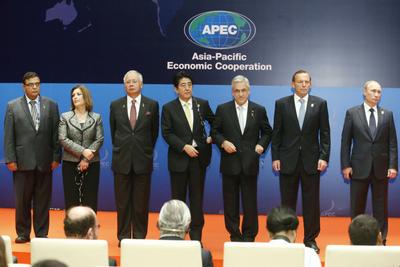A recent report by the World Economic Forum concludes that reducing supply chain barriers to trade could increase world GDP ‘over six times more than removing all tariffs’.
Under Indonesian leadership, the APEC process has been reoriented to the needs of business and to seize the gains available from a better-connected region. The 2013 declaration of APEC economic leaders looks beyond the 2020 Bogor deadline for free and open trade and investment. The ambition for regional economic integration has been raised to a vision of a ‘seamless and connected regional economy’. The APEC Framework on Connectivity explains how this is to be achieved by improving physical, institutional and people-to-people links among Asia Pacific economies.
Indonesia consulted closely with the next hosts of the APEC process to ensure the commitment to enhance connectivity is followed up. A blueprint to be presented to leaders in China in 2014 will elaborate the scope for reducing transaction costs. Targets for physical connectivity will include better regional transport and energy networks and universal broadband access. Institutional connectivity will aim for better cross-border financial cooperation and more coherent approaches to economic regulation, as well as modernised and harmonised customs procedures within a safe and trusted Information Coordination Technology and e-commerce environment. People-to-people links can be enhanced by expanding the coverage of the successful APEC Business Travel Card and by taking advantage of the revolution in higher education, as it moves towards massive open online courses.
China’s President, Xi Jinping, has recently announced the establishment of the Asian Infrastructure Investment Bank, to which other economies can contribute. This initiative will begin to steer more of the world’s private savings towards investment in productive economic infrastructure. The World Bank and other multilateral development banks will have a strong incentive to do the same. Therefore, finance will not be the immediate constraint to improving connectivity.
The main problems will be limits of skills and institutional capacity. All Asia Pacific governments will need to learn together to improve the quality of their domestic economic regulations and to modernise the institutions needed to plan, implement then operate massive investments in software and hardware. Building up the necessary capacity will not be achieved by trade liberalisation or by negotiating new rules. Even if a Free Trade Agreement of the Asia Pacific were negotiable, it would not create the capacity needed to connect the people and economies of the Asia Pacific. Once APEC leaders turn their attention to the gains available from practical cooperation to reduce transaction costs, it will be evident that they greatly exceed the marginal potential gains from any trade deals.
APEC’s new Multi-Year Plan on Infrastructure Development and Investment demonstrates a sound awareness of the problems that will need to be overcome. Cooperative policy development will concentrate on fostering a business-friendly environment for investment within a transparent and predictable regulatory framework; improving the capacity to generate a pipeline of bankable infrastructure projects within an integrated plan for the three dimensions of connectivity; and strengthening the financing environment to encourage long-term investors.
APEC’s history warns that it will not be easy to move past these studies of the policy problems and other obstacles to be overcome. So it is heartening to note that the blueprint for connectivity will identify individual or joint projects among Asia Pacific economies for early implementation. One of these could be a commitment to improve the efficiency of ports and airports in the region. Modest, feasible improvements towards already existing best practice would yield annual benefits greater than the dream of complete elimination of all remaining tariffs in the region.
Pilot projects to demonstrate the potential of better connectivity should fit into a coherent long-term strategy for Asia Pacific connectivity. As soon as possible, APEC governments should agree to finance the expertise needed to draw up a long-term plan for physical, institutional and people-to-people connectivity. That plan should be comparable in scope and quality to the excellent Master Plan for ASEAN Connectivity.
Finance Ministers will need to supervise the design and implementation of an APEC Master Plan on Connectivity — they have the economy-wide perspective to appreciate the potential benefits which justify the necessary investments in capacity-building, software and hardware. Finance ministers also have the experience of interacting with development banks and the private sector and the authority to allocate the public resources needed to catalyse private investment in better connectivity. Their work to design, finance then operate economic infrastructure could be supported by a high-level private sector group with expertise covering understanding financial markets, project preparation, management and implementation, including experience in the oversight of professional feasibility studies.
An APEC Master Plan on Connectivity should include ambitious, measurable but realistic targets for reducing specific transaction costs — for example, the cost of clearing and moving products through ports and airports, transport costs between economies, and reductions in the cost of high-quality broadband access. Such targets can be set for 2020, 2025, 2030 and beyond. Meeting medium-term targets for making international commerce cheaper, easier and faster will soon allow APEC leaders to point to significant and measurable gains from their cooperation.
Andrew Elek is a Research Associate at the Crawford School of Public Policy, Australian National University. He was the inaugural Chair of APEC Senior Officials in 1989.

